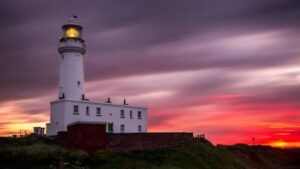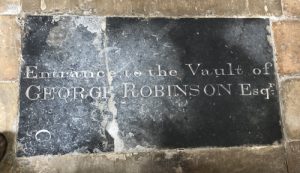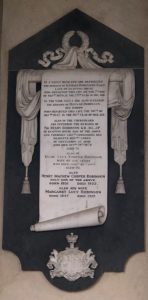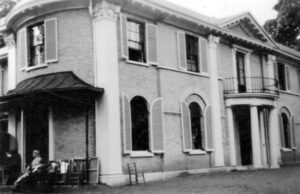The Robinson family were a wealthy family who moved to Knapton from the London area.
In Whites Directory of Norfolk, George owned land in Knapton including the area known as The Grove.
Sometime in the early 1800’s he built Knapton House for his family and also built Knapton New Hall.
George Robinson was an optics expert in London in the late 1700’s making parabolic reflectors from his factory at 24–25 Long-Acre Street in East London. These consisted of small facets of silvered glass (pieces of mirror) set in plaster of Paris which reflected the candles in lighthouses and were first used in about 1763. To produce a revolving or flashing light, the reflectors were fixed on a revolving carriage having several faces.
Robinson began working with Thomas Rogers in 1786 and formed a lens, lantern and lamp company. Beginning in the 1790s, their company became the chief supplier of reflectors and lamps to Trinity House, the British Lighthouse Authority. Rogers left the company to work in Ireland in 1792 and George Robinson became sole proprietor. The Robinson Company eventually took in 13 year old Robert Wilkins as an apprentice and later as a partner and the company became known as G. Robinson & Wilkins.
Beginning in the early 1800’s George Robinson also took on the additional responsibility of the Chief Inspector of lighthouses for Trinity House.
George Robinson built Trinity House’s Flamborough Head Lighthouse (seen on the right) in 1806 and went on to to supply the reflectors and lamps for a number of British lighthouses notably: St. Agnes, Longships, the Lizard, Hurst Castle, Dungeness, Orfordness, Tynemouth, St. Ann’s, the Smalls and the South Stack.
His equipment was also used in the first Australian lighthouse at Macquarie and at the Heligoland Lighthouse in Germany that was owned at that time by the British.

Flamborough Lighthouse
By the early 1820’s, the British Parliament had some concerns that George Robinson was both its lighthouse optics supplier and, at the same time, the Chief Inspector of lighthousesfor Trinity House. Soon after these questions were raised in 1822, Robinson sold his business to Robert Wilkins and the company became known as R. Wilkins & Co., although George remained the Chief Inspector of lighthouses for Trinity House for a few more years before retiring to Knapton.
George also invented the Foghorn, or Siren, being the first to construct an instrument by which successive puffs of air under pressure we ejected from the mouth of a pipe. He obtained this effect by using a stopcock revolving at high speed in such a manner that 720 pulsations per second were produced by the intermittent escape of air through the valves or ports, a smooth musical note being given.
We found this on the website of the 1911 Encyclopaedia Britannica.
The most powerful and efficient of all compressed air fog signals is the siren. The principle of this instrument may be briefly explained as follows: It is well known that if the tympanic membrane is struck periodically and with sufficient rapidity by air impulses or waves, a musical sound is produced.
By his improvements in the mode of illuminating Lighthouses adopted for the last half century and extended to various parts of the world he has been the humble means through Providence of greatly diminishing the loss of human life by Shipwreck and of saving a vast amount of property to the mercantile and shipping interests of this and other countries. For many years he filled the office of inspector of lighthouses to the Honourable Corporation of the Trinity House. His upright conduct and generosity effectually conciliated the high regard and esteem of the circle of his friends and acquaintance and his kindness of heart and benevolence to the poor were felt and acknowledged with gratitude by those around him’.
From the Norfolk Family History Group
George Robinson JP lived at Knapton House until his death on September 7th 1834 and is buried in a vault under the choir stalls in St Peter & St Paul’s Church, Knapton.

Engraved on a Ledger there is…
Entrance to the vault of George Robinson Esq

On the wall of St Peter & St Paul’s church, above the entrance to George Robinson’s vault, is the Vault Scroll (shown on the left) which names the other members of the family in the vault.
In a vault beneath are deposited the remains of George Robinson Esq. late of this parish who departed this life on the 7thday of September 1834 in the 73rd year of his age.
In the same vault beneath is his wife Hannah departed this life the 30th December 1857 in the 86th year of her age.
The only son, Henry, was Knighted by Queen Victoria in 1845 and lived in Knapton House from at least 1851 until his death in 1879 in Knapton.
Knight Bachelor – Created 1845 – Sir Henry Robinson, only son of George Robinson Esq of Knapton House, Norfolk by the eldest dau. of Henry Atkinson Esq of Bacton, Norfolk. Born in London; married 1842, youngest dau. of William Dodge Cooper Cooper Esq. of Toddington Park, Bedfordshire, was appointed in 1840 standard-bearer of the corps of gentleman-at-arms; and in 1845 promoted to the rank of Lieut. on which occasion he received the honour of knighthood; retired from the corps 1848; appointed a deputy lieut. of Norfolk 1850. Seat Knapton House
Extracted from: Website of the Gentlemen of Arms.

Knapton House in the late 1800s
Henry and his wife, Margaret Lucy Ketton (daughter of John Ketton, of Felbrigg) had three daughters and one son
Three of their children had died young by the year 1901, which left Constance their only surviving child
Evelyn Rachel Lucy Robinson
Born 1877 :: Died January 25 1901 :: Aged 23 :: Buried in St Peter & St Paul’s Churchyard, Knapton
Engraved on her stone: Blessed are the peacemakers for they Shall be called the Children of God
Gladys Lyndsey Robinson
Born November 14, 1885 :: Died January 16, 1903 :: Aged 18 :: Buried in St Peter & St Paul’s Churchyard, Knapton
Engraved on her gravestone: Thy Will be done
Henry Cooper Robinson
Born November 7, 1879 in Knapton :: Died 14th Aug 1899 :: Aged 20 :: Buried in St Peter & St Paul’s Churchyard, Knapton
Engraved on his stone: Blessed are the pure in heart for they shall see God
Constance Ellen Robinson
Born April 29, 1879 :: Died March 9, 1968 :: Aged 89 :: Buried in St Peter & St Paul’s Churchyard, Knapton
Plaque inside Church reads: In thankful memory of Constance Ellen Robinson 1879-1968 a most generous benefactress of this Church
